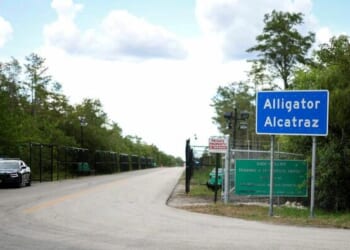Last week, I commented on the infeasibility of establishing a state-of-the-art data center on Australia’s Indian Ocean outpost Christmas Island. While the island is strategically well situated to monitor military movements in the Sunda Strait, Lombok Strait, and Malacca Strait, its distance from land—350 kilometers from Java and 1,500 kilometers from Australia—and the lack of access to cost-effective electricity and cooling resources militate against such a plan. Nonetheless, the island is a suitable staging post for Google’s undersea fiber cable from Darwin, Australia, to Singapore, announced in December last year.
Still, military experts have identified the need for data-processing and storage facilities to enable the deployment of AI-enabled drones and submersibles for surveillance and, in the event of war, uncrewed missile systems in remote ocean environments such as the Pacific and Indian Oceans. Locating strategically important (mission-critical) data storage in a frontline location such as Christmas Island makes it an easy target for foreign adversaries—as observed in the World War II Japanese bombing of the Christmas Island radio station.

The deployment of AI-controlled uncrewed equipment requires data-processing capability close to where the equipment is being deployed to minimize the latency (time taken to send messages from control to device) and jitter (packet loss in transmission), which compromise real-time control capability. However, operational processing needs are much more modest than those required to store data and to develop and train AI systems, which are the core functions of state-of-the-art data centers requiring vast amounts of electricity and cooling capacity. Software trained using AI systems can be downloaded and deployed in much less data-intensive environments.
When response speed is paramount, such as in the control of uncrewed high-precision military devices in real time, a customized set of software and data can be downloaded to a mobile data center deployed in the field of operations. The mobile center can operate independently, with backup exchange of data with the data center as required, using satellites or fiber connections as appropriate. This enables the rapid data response needed for controlling devices, while the data center can be located in a more easily defendable location—for both the center physically and the supply chain of resources required to keep it operating.
This suggests that for oceanic deployment, the mobile data-processing facility will be a ship, with data transmitted as required. In the first instance, data exchange with the data center will be via satellite, with facilities such as Christmas Island serving as satellite base stations for relaying data on fiber connections to the data center (and vice versa).
The model has already been well proven by cruise shipping companies. Carnival Corporation, for example, has fitted some of its cruise ships with sophisticated sensing and computing capacity that allows it to track customers, operate security systems, and process a vast range of customer-facing data to run a huge range of on-ship processes. These are all able to be provided on ship in a low latency environment in real time, to optimize the experience of passengers on a particular cruise. Data is shared via satellite services with the shoreside Microsoft Azure cloud facilities. The shoreside data are analyzed to feed into corporate operations, reporting, and management and to develop new AI software to optimize customer experiences. The new software and other data can then be transferred to the ship as required, again using the satellite connections.
In essence, what Carnival has developed is a smaller, customized mobile data center on the ship, integrated into a sophisticated large shoreside data center facility, using data communications facilities. While the military version may have different shipside applications, and the shoreside facility will be a private rather than public cloud, the operating principles are the same.
In this context, the Christmas Island data hub will likely play a very important role in the overall defense of Australia and the Indian Ocean, even though it will not be housing a full data center. The site could house a low Earth orbit (LEO) ground station in conjunction with its fiber link. LEO systems use a network of ground stations to direct satellite data traffic over fiber connections to and from terrestrial data centers to further reduce latency. With Christmas Island proposed as a hub connecting with Google stations in the Maldives, Darwin, and Singapore (see maps), the region’s data transport resources will be more resilient as well as faster, benefiting all military, commercial and social purposes.
The post Mobilizing Data for the Military and Beyond appeared first on American Enterprise Institute – AEI.














